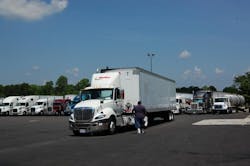Driver pay scales are rapidly becoming complicated as fleets across the trucking spectrum – from for-hire to private – seek to reduce turnover and bring in new blood.
In a conference call hosted by Stifel Financial Corp., Gordon Klemp – founder and president of the National Transportation Institute (NTI) – and Leah Shaver, NTI’s COO, said regionalized pay packages began being deployed in 2008 and rapidly spread across the industry, quickly followed by “niche pay” packages aimed at specialized services such as hazardous materials transportation.
“Since 2010, one carrier we cover has implemented 13 different iterations of its pay package for company drivers and something of same magnitude for its independent contractors,” Klemp said. “This is a much more sophisticated way to approach market and also takes advantage of niche pay trends.”
He also expects the deployment of “safety pay” to keep growing, with one fleet tracked by NTI offering a 10% bonus last year for accident-free safe driving on top of a 13% bonus offered in 2013. “We’ll see more of those,” Klemp emphasized.
He noted that trucking has also experienced an “unusual” short-term spike in pay increases that continued even as freight rates began to get weaker at the end of last year.
“This pay cycle is very unusual,” Klemp pointed out. “It started in July 2014 and ended in January 2016; one of the shortest pay [increase] cycles – just 19 months – than we’ve ever seen, and by a lot, as pay [increase] cycles averaged 33 months over the last 20 years.”He added that for 2015, driver pay scales remain much higher in the private fleet sector compared to the for-hire long-hail haul TL segment.
Driver pay among private fleets in 2015 averaged $66,000 to $82,000 versus $54,000 in the for-hire segment – a gap made worse on the for-hire side by what Klemp calls “lumpy pay” and driver-paid living expenses.
“If a [for-hire] driver has a mechanical breakdown, it’s on their dime. If there is a weather delay or detention time, it’s all on their dime because they are not rolling miles,” he explained. “So while they may be making $54,000 in annual pay, it’s not in 52 week increments. That raises havoc on personal end of their life: they can’t pay the bills. So that creates turnover as they look for regularity.”
Klemp also emphasized that most for-hire drives still must pay for their meals and even showers on the road, cutting further into their pay. “And it’s hard to live on road for less $1,000 per month; that makes their $54,000 annual pay a lot lower,” he stressed.
That’s why many fleets – especially mid-sized and smaller carriers – are now offering guaranteed pay packages to eliminate “lumpy pay,” Klemp said, which – if handled correctly – is a far-less expensive proposition compared to turnover.
“On average, for-hire fleets suffer 100% turnover, [while] private fleets are down at 14% turnover. And I can’t come up model cost less than $5,000 to hire driver,” he noted. “There is great incentive to minimize turnover in truckload world. Even with a growing glut of drivers, [for-hire] carriers are still experiencing 100% turnover.”
The “glut” Klemp referred to is the growing problem of finding drivers with the right qualifications and safe records to hire.
“A lot of driver applications are ‘abysmal’ in the words of one fleet we talked to; one that rejected 2,300 driver applications,” he stressed. “So while there may be a lot of driver applications, there are not a lot fleets want to put on the payroll. This still remains a problem.”
Perhaps the greatest problem is that driver pay, tracked in parallel with inflation, remains far below what the industry used to offer over three decades ago.
“If you take 1980 average [driver] pay of $38,618 and index it to inflation, it normalizes at $111,455 today,” Klemp said. “And volatility of income per driver is much greater than what U.S. household income has been.”




